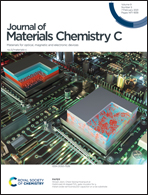High quantum yield boron-doped carbon dots: a ratiometric fluorescent probe for highly selective and sensitive detection of Mg2+ ions†
Abstract
As magnesium ions have been considered one of the most important cations for numerous physiological and pathological functions since the past century, the selective and specific detection of magnesium ions with chemosensors has drawn considerable interest and became essential in biomedical and biological studies. Herein, we report highly fluorescent boron-doped carbon dots (BCDs) that were synthesized via a simple solvothermal method utilizing catechol as a carbon source and naphthalene boronic acid as the boron source. The obtained BCDs exhibited violet luminescence with a quantum yield of 39.4%, which is higher than that obtained in any previous report. For the first time, the as-prepared BCDs were explored for the highly selective and sensitive detection of Mg2+ ions over Ca2+ ions. This method is based on a fluorescence property resulting from the strong complex formed between Mg2+ and BCDs, with a limit of detection (LOD) of about 39 μM, which is much less than the concentration range of intracellular Mg2+ ions in mammalian cells (0.5–0.7 mM). Remarkably, BCDs can be effectively reused upon gradual addition of EDTA to the BCDs–Mg2+ complex. The oxygen moieties on BCDs surfaces are probable active binding sites towards Mg2+ ions for enhancing the fluorescence. Therefore, BCDs could be useful for the detection of Mg2+ ions without using expensive instruments and materials. To the best of our knowledge, this is the first report on the detection of magnesium ions using carbon dots.



 Please wait while we load your content...
Please wait while we load your content...